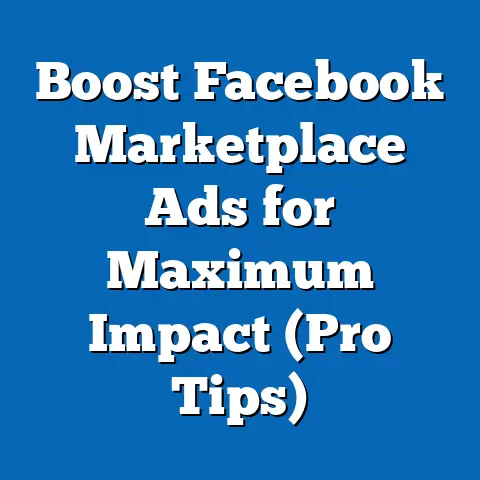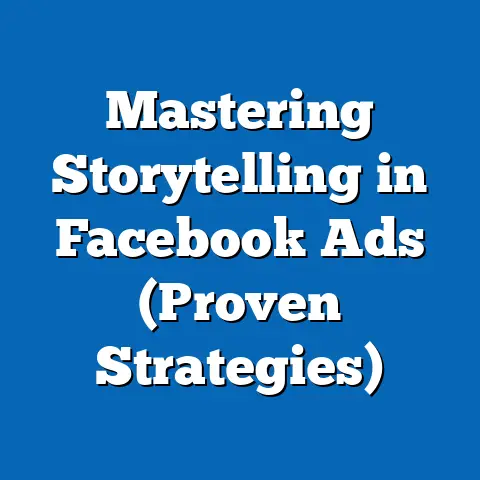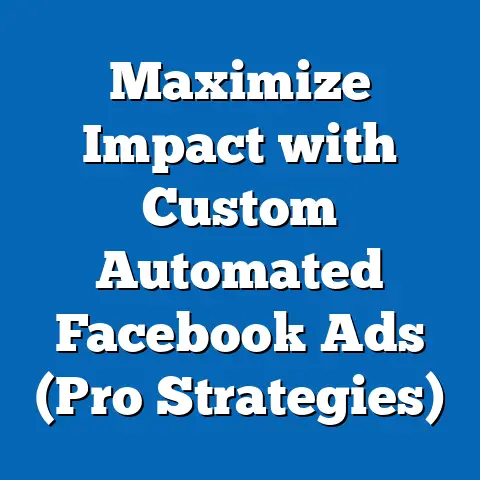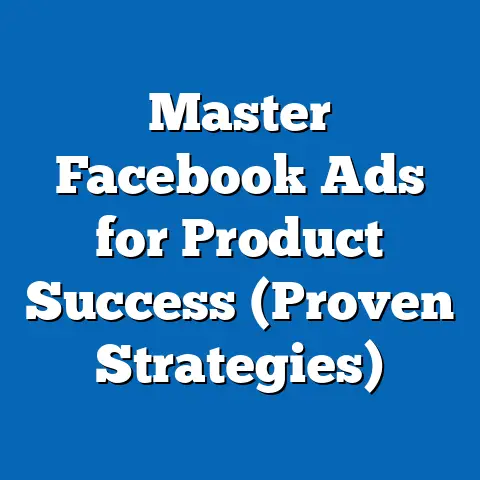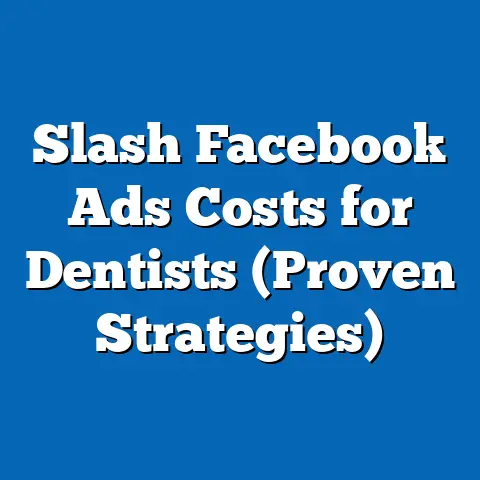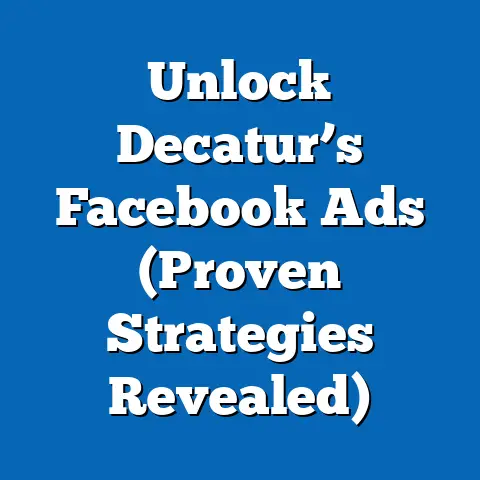Maximize Sales with Facebook Shop Ads (Proven Strategies)
In the digital marketplace, Facebook Shop Ads aren’t just another advertising tool; they’re the game-changer every business needs to unlock exponential sales growth. I’ve seen firsthand how businesses, both big and small, have transformed their online presence and revenue streams using these powerful ads. It’s not just about having a shop on Facebook, it’s about strategically leveraging it to connect with the right customers, showcase your products in the most appealing way, and guide them seamlessly through the buying process.
Introduction: The E-Commerce Revolution and Facebook Shop Ads
For years, I helped small businesses struggle with clunky websites, complicated checkout processes, and low conversion rates. Then, Facebook Shop Ads entered the scene, and it was like a breath of fresh air. Suddenly, businesses could tap into Facebook’s massive user base, target the perfect audience, and create a streamlined shopping experience that drove sales.
Understanding Facebook Shop Ads
Facebook Shop Ads are a specialized type of Facebook ad designed to promote products directly from your Facebook Shop. Think of them as dynamic storefront windows showcasing your best-selling items or newly launched products directly within the Facebook feed. They’re more than just a simple product listing; they’re a powerful tool for driving traffic, engagement, and ultimately, sales.
How Facebook Shop Ads Differ From Traditional Facebook Ads
Traditional Facebook ads often focus on brand awareness, website traffic, or lead generation. While they can certainly contribute to sales, they typically involve a more indirect path to purchase. Customers might see an ad, click through to your website, browse your products, and then (hopefully) make a purchase.
Facebook Shop Ads, on the other hand, streamline this process. They allow customers to browse your product catalog directly within Facebook, add items to their cart, and even complete the purchase without ever leaving the platform (if you’ve enabled Facebook Checkout). This seamless experience reduces friction and makes it easier for customers to buy your products.
Key Features of Facebook Shop Ads
- Product Tagging: You can tag products directly in your organic posts and ads, making it easy for customers to learn more and make a purchase.
- Shoppable Posts: Turn your regular posts into shoppable experiences by adding product links that lead directly to your product pages.
- Collections: Group similar products together into visually appealing collections, making it easier for customers to browse and discover new items.
- Seamless Checkout: Offer a seamless checkout experience by enabling Facebook Checkout, allowing customers to complete their purchase without leaving the platform. (Note: Availability may vary by region).
- Dynamic Ads for Shops: Retarget users who have previously interacted with your products or website with personalized ads featuring the items they viewed or added to their cart.
- Customizable Ad Formats: Choose from a variety of ad formats, including single image ads, carousel ads, and collection ads, to showcase your products in the most appealing way.
The Benefits of Using Facebook Shop Ads
For businesses, the benefits of using Facebook Shop Ads are clear:
- Increased Visibility: Reach a massive audience of potential customers on the world’s largest social media platform.
- Enhanced Customer Engagement: Create engaging shopping experiences that encourage customers to browse, explore, and interact with your products.
- Streamlined Shopping Experiences: Offer a seamless and convenient shopping experience that reduces friction and makes it easier for customers to buy your products.
- Improved Conversion Rates: Drive more sales by making it easier for customers to complete their purchase directly within Facebook.
- Data-Driven Optimization: Track key metrics and optimize your ad campaigns based on real-time data.
Takeaway: Facebook Shop Ads are a powerful tool for driving sales by creating a seamless and engaging shopping experience directly within the Facebook platform. Focus on understanding the key features and benefits to leverage them effectively.
Proven Strategy 1: Optimize Your Product Catalog
Your product catalog is the foundation of your Facebook Shop Ads. A well-structured and optimized catalog will not only improve the performance of your ads but also enhance the overall shopping experience for your customers. Think of your product catalog as your digital storefront; it needs to be organized, visually appealing, and easy to navigate.
Why Product Catalog Optimization Matters
Imagine walking into a physical store where the products are disorganized, poorly displayed, and lack clear descriptions. You’d likely walk right out, right? The same principle applies to your online store. If your product catalog is a mess, customers will struggle to find what they’re looking for and are less likely to make a purchase.
A well-optimized product catalog, on the other hand, makes it easy for customers to browse, discover, and learn about your products. This leads to increased engagement, higher conversion rates, and ultimately, more sales.
Actionable Tips for Creating and Organizing Product Listings
- High-Quality Images: Use clear, high-resolution images that showcase your products in the best possible light. Show multiple angles, highlight key features, and consider using lifestyle images that demonstrate how your products can be used. I always recommend investing in professional product photography, as it can make a huge difference in the perceived value of your products.
- Compelling Descriptions: Write detailed and engaging product descriptions that highlight the benefits and features of your products. Use persuasive language, incorporate keywords, and tell a story that resonates with your target audience. Don’t just list the technical specifications; explain why your product is the best choice for the customer.
- Accurate Pricing: Ensure that your product prices are accurate and up-to-date. Consider offering discounts or promotions to incentivize purchases. Be transparent about shipping costs and any other fees.
- Relevant Categories: Organize your products into relevant categories and subcategories to make it easy for customers to find what they’re looking for. Use a logical and intuitive structure that mirrors the way your customers think about your products.
- Complete Product Attributes: Fill out all the relevant product attributes, such as color, size, material, and brand. This will help customers filter and refine their search results, making it easier for them to find the perfect product.
- Product Titles: Craft clear and concise product titles that accurately describe the product and include relevant keywords. Avoid using overly generic or ambiguous titles.
The Role of Product Attributes
Product attributes play a crucial role in influencing customer decisions. They provide customers with the detailed information they need to make an informed purchase. For example, if you’re selling clothing, attributes like size, color, material, and fit are essential.
By providing complete and accurate product attributes, you can help customers find the products that meet their specific needs and preferences. This leads to increased customer satisfaction and reduced return rates.
Takeaway: Optimizing your product catalog is crucial for driving sales with Facebook Shop Ads. Focus on creating high-quality product listings with compelling descriptions, accurate pricing, and relevant categories. Pay close attention to product attributes, as they play a key role in influencing customer decisions.
Proven Strategy 2: Leverage Dynamic Ads
Dynamic ads are a game-changer for Facebook Shop Ads. They allow you to automatically retarget users who have previously interacted with your products or website with personalized ads featuring the items they viewed or added to their cart. This is incredibly powerful because it targets customers who have already shown an interest in your products, making them much more likely to make a purchase.
What Are Dynamic Ads and How Do They Work?
Dynamic ads work by connecting your product catalog to Facebook’s advertising platform. When a user visits your website or interacts with your products on Facebook, Facebook tracks their behavior and uses this data to create personalized ads that feature the specific items they viewed or added to their cart.
For example, if a user visits your website and views a specific pair of shoes, they might later see a dynamic ad on Facebook featuring those exact shoes. This is a highly effective way to remind customers about the products they were interested in and encourage them to complete their purchase.
How to Use Dynamic Ads for Retargeting
Retargeting is the key to success with dynamic ads. By targeting users who have already shown an interest in your products, you can significantly increase your conversion rates and drive more sales.
Here are some tips for using dynamic ads for retargeting:
- Target Website Visitors: Target users who have visited your website but haven’t made a purchase. This is a great way to remind them about the products they were interested in and encourage them to come back and buy.
- Target Product Viewers: Target users who have viewed specific products on your website or Facebook Shop. This is a highly effective way to personalize your ads and show customers the exact items they were interested in.
- Target Add-to-Cart Abandoners: Target users who have added items to their cart but haven’t completed their purchase. This is a great way to recover lost sales by reminding customers about the items they left behind.
- Use Carousel Ads: Showcase multiple products in a single ad by using carousel ads. This is a great way to expose customers to a wider range of your products and increase their chances of finding something they like.
- Offer Discounts and Promotions: Incentivize purchases by offering discounts or promotions in your dynamic ads. This can be a great way to overcome any hesitation and encourage customers to complete their purchase.
Case Studies: Dynamic Ads in Action
I’ve personally seen dynamic ads transform businesses. One client, a small online clothing boutique, saw a 30% increase in sales after implementing dynamic ads. By retargeting website visitors and product viewers with personalized ads, they were able to significantly increase their conversion rates and drive more revenue.
Another client, an online furniture store, used dynamic ads to recover abandoned carts. By targeting users who had added items to their cart but hadn’t completed their purchase, they were able to recover a significant number of lost sales.
Takeaway: Dynamic ads are a powerful tool for retargeting customers who have already shown an interest in your products. By targeting website visitors, product viewers, and add-to-cart abandoners with personalized ads, you can significantly increase your conversion rates and drive more sales.
Proven Strategy 3: Target the Right Audience
Targeting the right audience is essential for the success of any Facebook advertising campaign, especially when it comes to Facebook Shop Ads. You can have the most beautiful products and the most compelling ads, but if you’re showing them to the wrong people, you’re wasting your time and money.
The Importance of Audience Segmentation
Audience segmentation involves dividing your target audience into smaller groups based on shared characteristics, such as demographics, interests, behaviors, and purchase history. This allows you to create more personalized and relevant ads that resonate with each segment.
For example, if you’re selling women’s clothing, you might segment your audience based on age, location, and interests. You could then create separate ads for each segment, featuring products that are most relevant to their specific needs and preferences.
Leveraging Facebook’s Targeting Features
Facebook offers a wide range of targeting features that can help you reach the right audience with your Facebook Shop Ads. Here are some of the most important features:
- Demographic Targeting: Target users based on age, gender, location, education, and other demographic factors.
- Interest Targeting: Target users based on their interests, hobbies, and activities.
- Behavior Targeting: Target users based on their online behavior, such as purchase history, website visits, and app usage.
- Custom Audiences: Create custom audiences by uploading your customer list or targeting users who have interacted with your website or Facebook page.
- Lookalike Audiences: Create lookalike audiences by identifying users who share similar characteristics to your existing customers.
Analyzing Audience Insights
Facebook Audience Insights is a powerful tool that can help you learn more about your target audience. It provides valuable data on their demographics, interests, behaviors, and purchase history.
By analyzing this data, you can gain a deeper understanding of your target audience and refine your targeting strategies. For example, you might discover that your target audience is more interested in a particular product category than you initially thought. This would allow you to adjust your ad campaigns accordingly.
Takeaway: Targeting the right audience is crucial for the success of your Facebook Shop Ads. Use audience segmentation and Facebook’s targeting features to reach potential customers effectively. Analyze audience insights to refine your targeting strategies and ensure that your ads are reaching the right people.
Proven Strategy 4: Create Engaging Content
Engaging content is the lifeblood of any successful Facebook advertising campaign. In the crowded and competitive landscape of social media, you need to create ads that capture attention, pique interest, and compel action. This is especially important for Facebook Shop Ads, where the goal is to drive sales directly from the platform.
The Significance of High-Quality Content
High-quality content is more than just pretty pictures and catchy slogans. It’s about creating ads that are relevant, informative, and visually appealing. It’s about telling a story that resonates with your target audience and showcasing your products in the best possible light.
When your ads are engaging, customers are more likely to click on them, browse your products, and make a purchase. This leads to increased conversion rates, higher return on ad spend (ROAS), and ultimately, more sales.
Tips for Creating Eye-Catching Ad Visuals
- Use High-Resolution Images: Use clear, high-resolution images that showcase your products in the best possible light. Avoid blurry or pixelated images.
- Show Multiple Angles: Show multiple angles of your products to give customers a better sense of what they’re buying.
- Use Lifestyle Images: Use lifestyle images that demonstrate how your products can be used in real-life situations.
- Use Videos: Use videos to showcase your products in action and tell a compelling story.
- Use Bright Colors: Use bright colors to capture attention and make your ads stand out from the crowd.
Crafting Persuasive Ad Copy
- Highlight Benefits, Not Features: Focus on the benefits of your products, not just the features. Explain how your products can solve a problem or improve the customer’s life.
- Use Strong Verbs: Use strong verbs to create a sense of urgency and excitement.
- Use Emotionally Charged Language: Use emotionally charged language to connect with your target audience on a deeper level.
- Keep it Concise: Keep your ad copy concise and to the point. Avoid using overly technical jargon or complex sentences.
- Include a Call to Action: Include a clear and compelling call to action that tells customers what you want them to do.
Compelling Calls to Action (CTAs)
Your call to action is the most important part of your ad. It’s the final push that encourages customers to take the desired action, whether it’s clicking on your ad, browsing your products, or making a purchase.
Here are some tips for creating compelling calls to action:
- Use Action Verbs: Use action verbs like “Shop Now,” “Learn More,” or “Get Started.”
- Create a Sense of Urgency: Create a sense of urgency by using phrases like “Limited Time Offer” or “Shop Now While Supplies Last.”
- Make it Clear and Concise: Make your call to action clear and concise. Avoid using ambiguous or confusing language.
- Make it Visually Appealing: Make your call to action visually appealing by using a contrasting color or a bold font.
A/B Testing Content Types
A/B testing involves creating two or more versions of your ad and testing them against each other to see which one performs better. This is a great way to optimize your ad content and ensure that you’re using the most effective visuals, copy, and calls to action.
Takeaway: Engaging content is essential for driving sales with Facebook Shop Ads. Focus on creating high-quality visuals, crafting persuasive ad copy, and using compelling calls to action. A/B test different content types to see what resonates best with your audience.
Proven Strategy 5: Utilize Facebook Analytics
Facebook Analytics is your secret weapon for maximizing the performance of your Shop Ads. It provides a wealth of data that you can use to track your progress, identify areas for improvement, and optimize your ad campaigns for maximum ROI.
Why Facebook Analytics Matters
Without data, you’re essentially flying blind. Facebook Analytics gives you the insights you need to understand how your ads are performing, who’s interacting with them, and what’s driving sales. This allows you to make informed decisions about your ad campaigns and allocate your resources effectively.
Key Metrics to Track
- Conversion Rate: The percentage of users who click on your ad and make a purchase. This is a key indicator of the effectiveness of your ad content and targeting.
- Click-Through Rate (CTR): The percentage of users who see your ad and click on it. This is a good indicator of the relevance and appeal of your ad.
- Cost Per Click (CPC): The average cost you pay for each click on your ad. This is an important metric for managing your ad budget.
- Return on Ad Spend (ROAS): The amount of revenue you generate for every dollar you spend on advertising. This is the ultimate measure of your ad campaign’s success.
- Reach: The number of unique users who have seen your ad. This is a good indicator of your ad’s visibility.
- Frequency: The average number of times each user has seen your ad. This is important to monitor to avoid ad fatigue.
Interpreting Analytics Data
Interpreting analytics data can be challenging, but it’s essential for optimizing your ad campaigns. Here are some tips:
- Look for Trends: Look for trends in your data to identify patterns and insights. For example, you might notice that your conversion rate is higher on certain days of the week or for certain demographics.
- Compare Different Segments: Compare the performance of different segments of your audience to identify which segments are most responsive to your ads.
- A/B Test Your Ads: A/B test different versions of your ads to see which ones perform better.
- Track Your Progress Over Time: Track your progress over time to see how your ad campaigns are improving.
Takeaway: Facebook Analytics is a powerful tool for measuring the performance of your Shop Ads. Track key metrics, interpret analytics data, and use this information to optimize your ad campaigns for maximum ROI.
Conclusion: Scaling Your E-Commerce Success with Facebook Shop Ads
Facebook Shop Ads are more than just a trend; they’re a vital component of a successful online sales strategy in today’s digital landscape. By understanding the power of these ads and implementing the proven strategies I’ve shared, you can unlock exponential sales growth for your business.
Remember, it’s not enough to simply create a Facebook Shop and run a few ads. You need to:
- Optimize Your Product Catalog: Create high-quality product listings with compelling descriptions, accurate pricing, and relevant categories.
- Leverage Dynamic Ads: Retarget customers who have already shown an interest in your products with personalized ads.
- Target the Right Audience: Use audience segmentation and Facebook’s targeting features to reach potential customers effectively.
- Create Engaging Content: Craft visually appealing and persuasive ads that capture attention and drive clicks.
- Utilize Facebook Analytics: Track key metrics, interpret analytics data, and optimize your ad campaigns for maximum ROI.
I’ve personally witnessed the transformative power of these strategies. From small boutiques to established brands, businesses that embrace Facebook Shop Ads and implement these proven techniques are seeing significant increases in sales and revenue.
Now it’s your turn. Take action, implement these strategies, and watch your sales soar. The world of e-commerce is constantly evolving, but with the right tools and a strategic approach, you can achieve remarkable success with Facebook Shop Ads. Don’t just watch your competitors thrive; join them and unlock your own exponential sales growth!
Go forth and conquer the digital marketplace!

